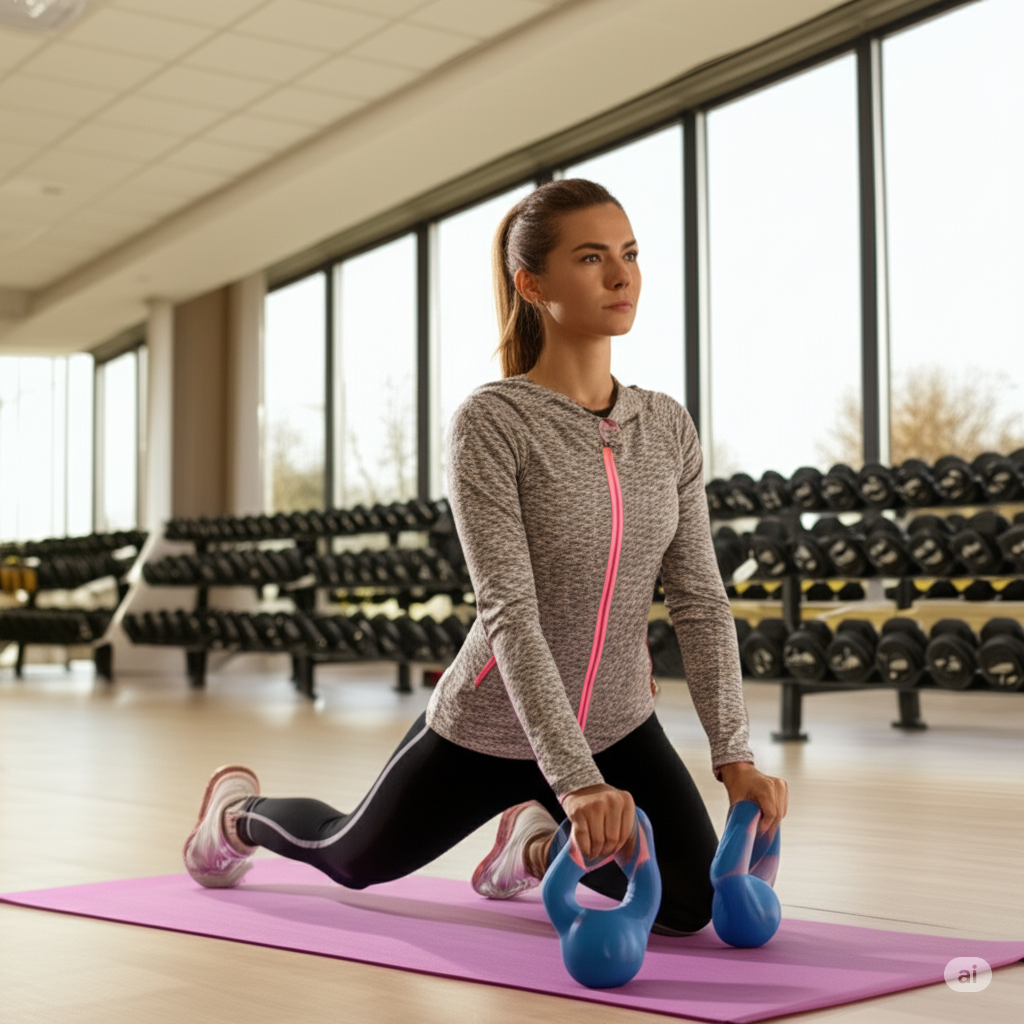Introduction
In the pursuit of fitness, many embark on a journey driven by singular goals, often focusing heavily on one type of exercise. However, the secret to sustainable progress, injury prevention, and true well-being lies in a holistic approach. This guide will help you understand why a comprehensive fitness plan is paramount in 2025 and how to effectively build a weekly fitness plan that genuinely works for you. Creating a solid weekly fitness plan is crucial for anyone aiming for consistent and lasting results.

Why a Balanced Workout Plan Matters
Many people start working out by doing too much of one thing—like all cardio or just weights—and quickly hit a plateau, burn out, or get injured. In 2025, a balanced workout is the gold standard for long-term health and performance. Achieving a truly balanced workout routine is crucial because it blends these vital components:
- Strength training: To build muscle, increase power, and support bone health, crucial for everyday function and longevity.
- Cardiovascular exercise: To improve endurance, boost heart and lung function, and enhance overall stamina.
- Mobility and recovery work: To prevent injuries, improve flexibility, reduce muscle soreness, and support long-term performance and mental clarity.
This approach forms the foundation of a resilient weekly fitness plan. Together, these elements keep your body resilient, your mind clear, and your energy levels high, ensuring a holistic approach to your well-being.



The 3 Pillars of a Balanced Fitness Routine
A truly effective weekly fitness plan rests on three fundamental pillars: strength, cardio, and recovery. Neglecting any one of these can lead to imbalances, plateaus, and increased risk of injury.
1. Strength Training: Build Muscle, Strength & Stability
Strength training is the foundation of fitness in 2025—not just for bodybuilders but for everyone. It’s about building lean muscle mass, which plays a critical role in metabolic health and daily function. Integrating strength training into your weekly fitness plan is essential for overall physical resilience.
Benefits:
- Increases metabolism, helping with weight management
- Strengthens bones and joints, reducing the risk of osteoporosis and arthritis
- Reduces injury risk by strengthening supporting muscles and improving stability
- Improves body composition, leading to a leaner, stronger physique
Key Movement Types:
To ensure a comprehensive approach to strength, focus on these fundamental movement patterns:
- Push: Exercises where you push weight away from your body (e.g., push-ups, overhead press, bench press)
- Pull: Exercises where you pull weight towards your body (e.g., rows, pull-ups, face pulls)
- Hinge: Movements where you bend at the hips (e.g., deadlifts, kettlebell swings, good mornings)
- Squat: Exercises involving bending at the knees and hips (e.g., bodyweight squats, goblet squats, back squats)
- Core: Exercises that stabilize your trunk (e.g., planks, leg raises, Russian twists)
Recommended Schedule:
- 2–4 days/week depending on your specific goals and current experience level.
- Alternate muscle groups (e.g., upper/lower split) or opt for full-body circuits for efficiency.
- Always prioritize form over weight to ensure safety and maximize effectiveness.
Beginner Tip: Start with bodyweight exercises or resistance bands and focus on movement control to build a strong base for your weekly fitness plan.
2. Cardiovascular Training: Boost Endurance & Heart Health
Cardio isn’t just for runners—it actively supports your heart, lungs, and brain. Ensuring consistent cardio in your weekly fitness plan boosts heart health and overall stamina.
Types of Cardio:
- Zone 2 cardio (low to moderate intensity): Ideal for fat burning, improving metabolic health, and building aerobic base. You should be able to hold a conversation but not sing.
- HIIT (High-Intensity Interval Training): Short, intense bursts of exercise followed by brief recovery periods. Excellent for time-saving workouts and improving anaerobic capacity.
- Steady-State: Consistent, moderate intensity for a longer duration (e.g., jogging, cycling, swimming, elliptical).
Benefits:
- Improves stamina and overall endurance
- Supports efficient fat metabolism
- Reduces blood pressure and resting heart rate, contributing to heart health
- Enhances mood, reduces stress, and improves sleep quality
Recommended Schedule:
- Aim for at least 150 minutes of moderate-intensity cardio per week, or
- 75 minutes of vigorous-intensity cardio, or
- A mix of both, typically broken into 3–5 sessions per week.
Tip: For Zone 2, you can talk but can’t sing while exercising. Try brisk walking, using an incline on the treadmill, or a light jog.
3. Recovery & Mobility: The Hidden Secret to Progress
Recovery isn’t passive—it’s an active and essential work that helps your body grow stronger and adapt to training stress. Without proper recovery, your muscles can’t rebuild, your nervous system can’t rebalance, and you’re more likely to burn out or get injured. No weekly fitness plan is complete without dedicated recovery.
Recovery Practices:
- Sleep: Aim for 7–9 hours of quality sleep per night for optimal muscle repair and hormonal balance.
- Foam rolling or myofascial release: To alleviate muscle tightness and improve blood circulation.
- Mobility routines: Focus on improving the range of motion in key joints like shoulders, hips, and spine.
- Breathwork or meditation: To calm the nervous system and reduce overall stress.
- Active recovery days: Light activities such as walking, gentle swimming, or stretching can promote blood flow and aid recovery without intense strain.
Mobility Workouts to Try:
- Dynamic stretching: Perform before workouts (e.g., leg swings, arm circles) to prepare your body for movement.
- Static stretching: Perform after workouts (e.g., hamstring stretch, child’s pose) to improve flexibility.
- Yoga: Practicing once or twice a week is excellent for improving flexibility, balance, and mental reset.
Tools: Modern recovery tools like massage guns, resistance bands, and lacrosse balls can assist in self-myofascial release. Mobility apps (like ROMWOD or StretchIt) also provide guided routines.
Sample Weekly Fitness Plan
Here’s a sample weekly fitness plan for a beginner aiming to improve overall strength and endurance, training 5 days/week.
| Day | Workout Type | Example |
| Monday | Strength (Upper Body) | Push-ups, rows, dumbbell press |
| Tuesday | Cardio (Zone 2) | 30-min brisk walk or cycling |
| Wednesday | Strength (Lower Body + Core) | Squats, lunging, glute bridges, plank |
| Thursday | Recovery + Mobility | Yoga or light stretching |
| Friday | HIIT + Core | Jump squats, mountain climbers, plank |
| Saturday | Optional: Active Fun | Dance class, hike, swimming, recreational sports, etc. |
| Sunday | Full Rest or Light Walk | Let your body recharge completely |
Summary
Crafting an effective weekly fitness plan that balances strength, cardio, and recovery is the most sustainable and effective path to achieving your fitness goals in 2025. By understanding the importance of each pillar, setting realistic expectations, and committing to a consistent routine, you can build a resilient body, a clear mind, and sustained energy. Remember, fitness is a journey of consistency and mindful effort across all aspects of your well-being.
Want even more practical health and wellness tips? Explore our full collection of articles in the Health Tips category.
What part of building your weekly fitness plan are you most excited to integrate into your week?
Ignite Your Drive: Powerful Motivational Quotes for Taking Action
Introduction Inspiration…
Crunchy Cabbage and Carrot Slaw with Zesty Mustard Seeds
✅ Vegan…
Popular Restaurants & Cafes in Shimla with Addresses
Introduction: Shimla…
Chandratal Lake – The Moon Lake Trek and Camping Guide
Introduction Tucked…
The Power of Hope
Why hope…
Top 10 System Design Interview Questions (2025 Edition)
1. Design…








